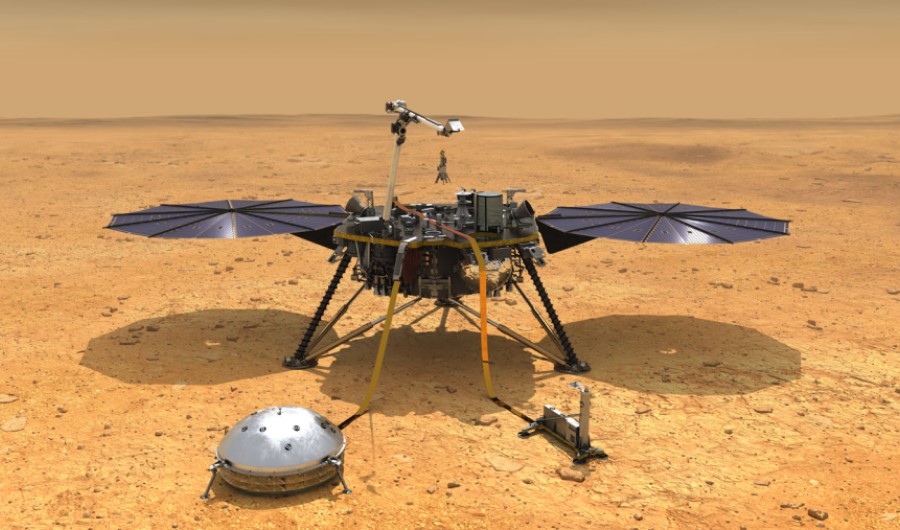Mars Regularly Shakes from Quakes, NASA Lander Finds

This artist's concept depicts NASA's InSight lander after it deployed its instruments on the Martian surface.
(Inside Science) -- NASA's InSight lander has detected the first clear signs of quakes on Mars, rumbles from mysterious sources that generate ripples scientists are using to probe the red planet's hidden interior, new studies find.
InSight arrived on Mars Nov. 26, 2018, touching down in a small impact crater nicknamed Homestead Hollow in Elysium Planitia, a volcanic plain straddling the Martian equator. Within the first 10 months of InSight's landing, it detected 174 quakes across the planet. It has since detected a total of roughly 450, and the number keeps climbing.
"We've finally for the first time established that Mars is a seismically active planet," said planetary scientist Bruce Banerdt at NASA's Jet Propulsion Laboratory in Pasadena, California, principal investigator of the InSight mission. "Its seismological activity is greater than that of the moon, as measured by the Apollo program, but less than the Earth's."
More than 20 of the initial 174 marsquakes were magnitude 3 to 4, and apparently came from distant sources. The researchers pinpointed the location of two of the larger marsquakes to the Cerberus Fossae region, a series of fissures roughly 1,600 kilometers to the east.
Previous research suggested Cerberus Fossae was formed by faults that pulled the crust apart, and prior work also found signs of a lava flow less than 10 million years old in the region. All this suggested this area may still have active tectonics and magma, potentially explaining the larger marsquakes InSight discovered.
"It is surprising that there is geologically recent volcanism on Mars," said planetary scientist Suzanne Smrekar at NASA's Jet Propulsion Laboratory, deputy principal investigator of the InSight mission. "If you just take a simple model of Mars, it would not be hot enough to be producing magma anymore, so it probably says there is some variability at Mars' depths that's not obvious at the surface." For example, underground clusters of radioactive materials such as uranium or volatile compounds such as water could make it easier for rocks to melt in certain regions, "allowing localized pockets of volcanism to occur," she said.
The rest of the 174 marsquakes were magnitude 3 and less. The frequency of these minor quakes was similar to the level of seismic activity seen on Earth in the relatively quiet interiors of tectonic plates, the researchers said.
"Right now we're looking at lots of different mechanisms causing these quakes," Banerdt said. Possible causes include landslides and pressurized water, he added.
Oddly, although InSight's pressure sensors detected the kind of wind patterns scientists would expect from small whirlwinds known as dust devils, its cameras "have seen no dust devils at all," said Don Banfield, a planetary scientist at Cornell University in Ithaca, New York. "This suggests maybe we don't understand dust lifting very well at Mars, and there is apparently some reason that this site doesn't allow dust devils to show up." Moreover, "from orbit, we do see dust being moved on the ground, because some of the dust devils that go by leave tracks," Banfield said. "So this is a puzzle we don't fully understand and frankly were surprised by."
Despite not seeing any dust devils on the ground, InSight detected more than 10,000 pressure vortices normally associated with the whirlwinds, making Homestead Hollow the area with the greatest numbers of these vortices of any Martian landing site to date.
InSight also discovered the local magnetic field at the landing site was 10 times stronger than expected given previous satellite measurements. The researchers suggested that strongly magnetized rock within about 150 kilometers of the landing site likely explained this magnetic data. The magnetized rock could be buried under up to 10 kilometers of lava flows. Geological maps suggested that much or all of this rock was at least 3.9 billion years old, consistent with prior work suggesting Mars once had a dynamo of flowing metal within its core that powered a global magnetic field with Earth-like strength.
"This volcanic rock formed when Mars had a global magnetic field, and little magnetic minerals in the rock lined up with that field, and when it cooled, magnetization was frozen into the rock," said planetary geophysicist Catherine Johnson at the University of British Columbia in Vancouver, a co-investigator on the InSight mission.
Analyzing the seismic waves from marsquakes and other sources revealed the uppermost 10 kilometers of the Martian crust appeared highly fractured, perhaps by meteorite impacts or flowing water, said Philippe Lognonne, a planetary seismologist at the University of Paris. Early models of the Martian crust actually suggested it was fairly broken, and these new findings "tell us it is more broken up than people have thought of recently," Smrekar said.
The scientists hope InSight will see larger quakes, which "will allow us to probe more deeply into the planet," Banerdt said. "We're still trying to get our arms around what Mars is telling us -- this is an entirely new world of processes for us."
The scientists detailed their findings in a suite of studies in the journals Nature Geoscience and Nature Communications.

